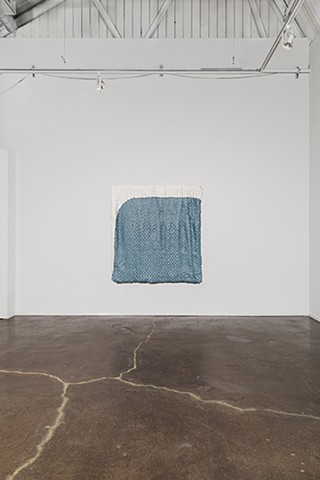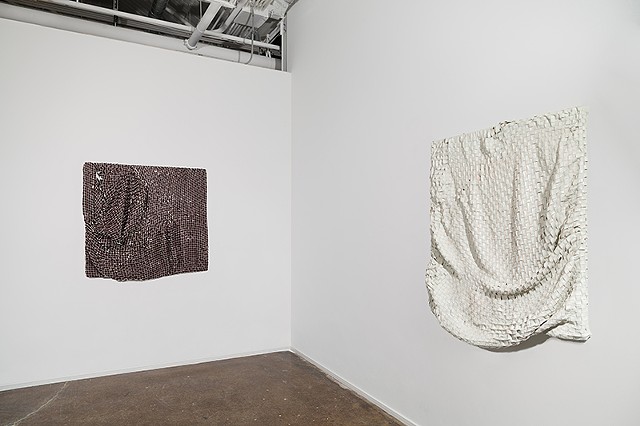Buoyant Surface, Chicago Artists Coalition, 2018
*Exhibition essay
Solo Exhibition, Chicago Artists Coalition, 2018
The Field is Woven
by Ionit Behar
Jean Alexander Frater’s works are like maps, traced by lines that escape geometry––“fugitives from geometricization,” as Deleuze and Guattari said. Rather than constraining difference, repetition and intuition allow Frater to produce difference, whereby multiplying the variables. Frater’s surfaces invite for both a contemplative passivity and a performative enactment, bolting the viewer to the work, as if the encounter were to engender a state of radical flux. The woven surface––made out of teared canvas––is suspended and affixed to the frame, letting gravity do its work, pulling down the weight of the material resembling sagging-aging skin. The gravitational pull holds all things in place, establishing order while at the same time giving us an opportunity to experience irregularity.
Frater uses canvas, a ready-made material, to create a grid, which is itself a ready-made format. The canvas is also a grid, ripped from its original weave, only to be woven together again. Everything is revealed about how the works are made; by tearing the canvas, a second color is revealed underneath, producing multiple layers of disclosure. The painting becomes an “anti-painting” and the monochrome becomes an “anti-monochrome.” It is as if Frater is telling us “I owe you the truth in painting and I will tell it to you” (Paul Cézanne to Emile Bernard, 1905). The precise course of revealing the truthfulness of painting also reflects the impossibility of it.
The twisted, contorted, curled, decomposed grids have the features of living things, in a constant state of variation, stating the imbalances or oppositions between regularity and irregularity, precision and imprecision, detail and totality, chaotic and ordered. When looking at a checkerboard, the American philosopher John Dewey observed: “The squares run now vertically, now horizontally, now in one diagonal, now in another.” One can observe something similar when looking at a Piet Mondrian painting, or for that matter, when looking at any grid made by the human hand. Just as pure chaos requires organizing principles, a field (either in space or time) requires a frame of reference. I believe Frater’s painting are like “woven fields” endowed with both a dynamic spontaneity and a disposition to control: the most human contradiction.
Gilles Deleuze and Felix Guattari, A Thousand Plateaus: Capitalism and Schizophrenia (Athlone Press, London 1988) 499.
John Dewey, Art as Experience (New York: Berkley Pub. Group, 2005), 168.





